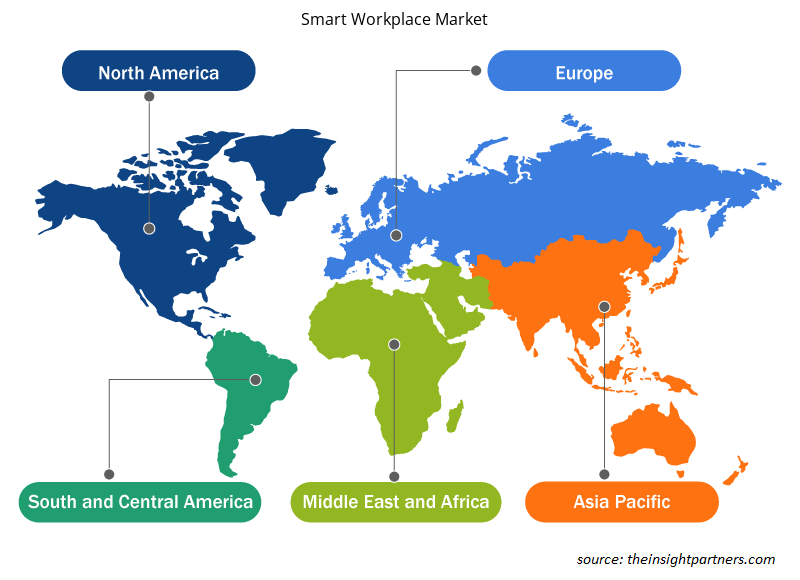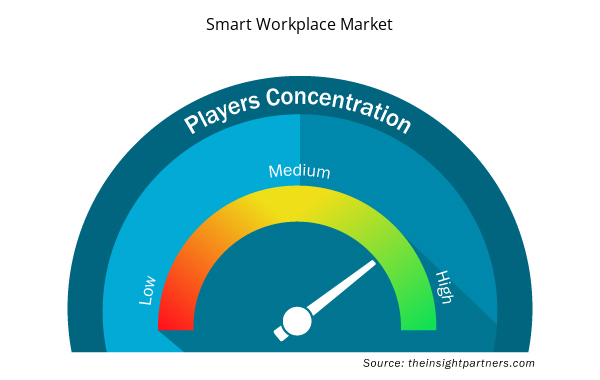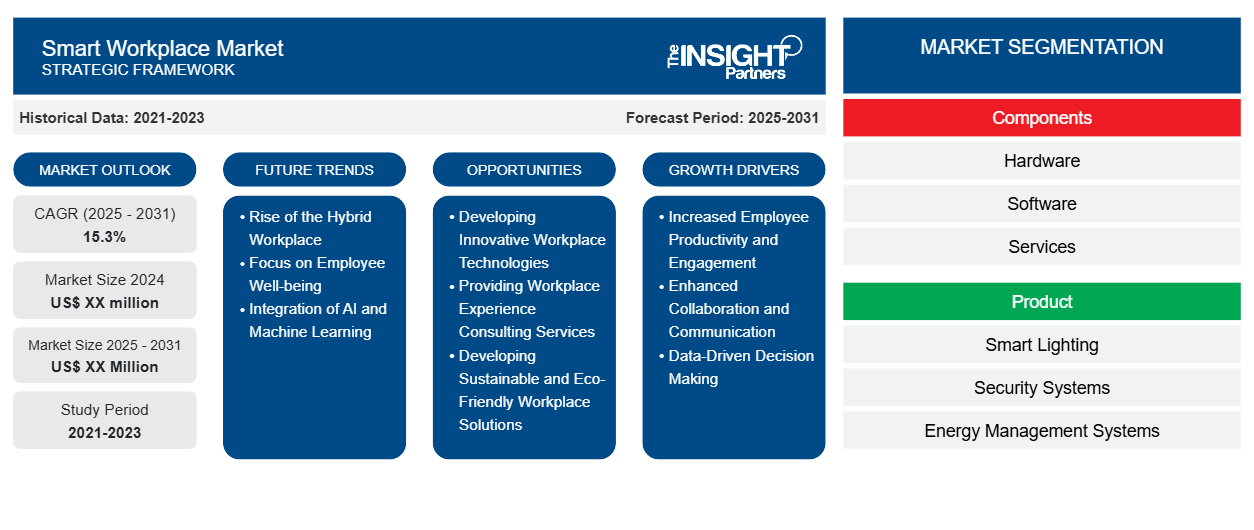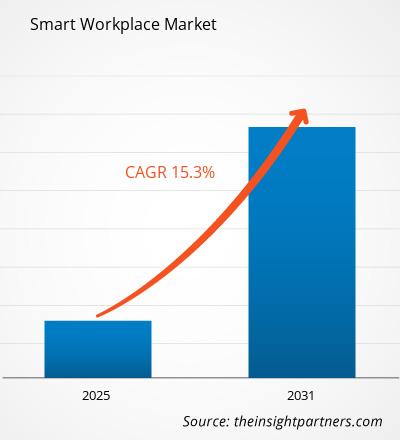Se espera que el mercado de lugares de trabajo inteligentes registre una CAGR del 15,3 % entre 2024 y 2031, y que el tamaño del mercado se expanda de XX millones de dólares estadounidenses en 2024 a XX millones de dólares estadounidenses en 2031.
El informe está segmentado en función de los componentes (hardware, software, servicios), por producto (iluminación inteligente, sistemas de seguridad, sistemas de gestión de energía, sistemas de control de HVAC, otros), por tamaño de la organización (pequeñas y medianas empresas, grandes empresas), por aplicación (oficinas modernizadas, oficinas de nueva construcción) y por vertical de la industria (BFSI, ciencias biológicas, TI y telecomunicaciones, sector público, comercio minorista, medios y entretenimiento, otros). El análisis global se desglosa aún más a nivel regional y por países principales. El análisis global se desglosa a nivel regional y por países principales. La evaluación del mercado se presenta en dólares estadounidenses para el análisis segmentario anterior.
Propósito del Informe
El informe Smart Workplace Market de The Insight Partners tiene como objetivo describir el panorama actual y el crecimiento futuro, los principales factores impulsores, los desafíos y las oportunidades. Esto proporcionará información a diversas partes interesadas del negocio, como:
- Proveedores/fabricantes de tecnología: Para comprender la dinámica cambiante del mercado y conocer las oportunidades potenciales de crecimiento, lo que les permitirá tomar decisiones estratégicas informadas.
- Inversionistas: Realizar un análisis exhaustivo de tendencias sobre la tasa de crecimiento del mercado, las proyecciones financieras del mercado y las oportunidades que existen en toda la cadena de valor.
- Órganos reguladores: Regular las políticas y vigilar las actividades del mercado con el objetivo de minimizar los abusos, preservar la confianza de los inversores y defender la integridad y la estabilidad del mercado.
Segmentación del mercado de los lugares de trabajo inteligentes
Componentes
- Hardware
- Software
- Servicios
Producto
- Iluminación inteligente
- Sistemas de seguridad
- Sistemas de gestión energética
- Sistemas de control de HVAC
Tamaño de la organización
- Pequeñas y medianas empresas
- Grandes empresas
Solicitud
- Oficinas modernizadas
- Oficinas de nueva construcción
Personalice este informe según sus necesidades
Obtendrá personalización en cualquier informe, sin cargo, incluidas partes de este informe o análisis a nivel de país, paquete de datos de Excel, así como también grandes ofertas y descuentos para empresas emergentes y universidades.
- Obtenga las principales tendencias clave del mercado de este informe.Esta muestra GRATUITA incluirá análisis de datos, desde tendencias del mercado hasta estimaciones y pronósticos.
Factores impulsores del crecimiento del mercado de los lugares de trabajo inteligentes
- Increased Employee Productivity and Engagement: Smart workplaces leverage technology to streamline workflows, automate tasks, and provide employees with the tools and resources they need to be productive and engaged. This can lead to increased efficiency, reduced costs, and improved employee satisfaction.
- Enhanced Collaboration and Communication: Smart workplace solutions facilitate seamless communication and collaboration among employees, regardless of their location. This can improve teamwork, accelerate decision-making, and foster a more inclusive and connected work environment.
- Data-Driven Decision Making: By collecting and analyzing data on employee behavior, workspace utilization, and other key metrics, organizations can gain valuable insights into how to optimize their workspaces and improve employee experience. This data-driven approach can lead to more informed decisions about workplace design, technology investments, and operational strategies.
Smart Workplace Market Future Trends
- Rise of the Hybrid Workplace: The future of work will likely involve a hybrid model, where employees work both remotely and in the office. Smart workplace solutions will need to adapt to this evolving model, providing employees with the flexibility and technology they need to be productive in any setting.
- Focus on Employee Well-being: Smart workplaces will increasingly prioritize employee well-being, incorporating features such as ergonomic workstations, access to natural light, and opportunities for physical activity. This focus on employee well-being will contribute to a healthier and more productive workforce.
- Integration of AI and Machine Learning: AI and machine learning will play an increasingly important role in smart workplaces, enabling organizations to automate routine tasks, personalize employee experiences, and gain deeper insights into workplace data.
Smart Workplace Market Opportunities
- Developing Innovative Workplace Technologies: There is significant opportunity for companies to develop and deploy innovative workplace technologies, such as AI-powered assistants, smart sensors, and virtual reality-based collaboration tools.
- Providing Workplace Experience Consulting Services: As organizations increasingly recognize the importance of creating engaging and productive work environments, there will be a growing demand for workplace experience consulting services to help them design, implement, and manage their smart workplace strategies.
- Developing Sustainable and Eco-Friendly Workplace Solutions: There is a growing demand for sustainable and eco-friendly workplace solutions, such as energy-efficient building technologies, waste reduction programs, and green commuting options.
Smart Workplace Market Regional Insights
The regional trends and factors influencing the Smart Workplace Market throughout the forecast period have been thoroughly explained by the analysts at Insight Partners. This section also discusses Smart Workplace Market segments and geography across North America, Europe, Asia Pacific, Middle East and Africa, and South and Central America.

- Get the Regional Specific Data for Smart Workplace Market
Smart Workplace Market Report Scope
| Report Attribute | Details |
|---|---|
| Market size in 2024 | US$ XX million |
| Market Size by 2031 | US$ XX Million |
| Global CAGR (2025 - 2031) | 15.3% |
| Historical Data | 2021-2023 |
| Forecast period | 2025-2031 |
| Segments Covered | By Components
|
| Regions and Countries Covered | North America
|
| Market leaders and key company profiles |
|
Smart Workplace Market Players Density: Understanding Its Impact on Business Dynamics
The Smart Workplace Market market is growing rapidly, driven by increasing end-user demand due to factors such as evolving consumer preferences, technological advancements, and greater awareness of the product's benefits. As demand rises, businesses are expanding their offerings, innovating to meet consumer needs, and capitalizing on emerging trends, which further fuels market growth.
Market players density refers to the distribution of firms or companies operating within a particular market or industry. It indicates how many competitors (market players) are present in a given market space relative to its size or total market value.
Major Companies operating in the Smart Workplace Market are:
- ABB Ltd.
- ATOSS Software AG
- Crestron Electronics, Inc.
- CISCO Systems, Inc.
- Johnson Controls Inc.
Disclaimer: The companies listed above are not ranked in any particular order.

- Get the Smart Workplace Market top key players overview
Key Selling Points
- Comprehensive Coverage: The report comprehensively covers the analysis of products, services, types, and end users of the Smart Workplace Market, providing a holistic landscape.
- Expert Analysis: The report is compiled based on the in-depth understanding of industry experts and analysts.
- Up-to-date Information: The report assures business relevance due to its coverage of recent information and data trends.
- Customization Options: This report can be customized to cater to specific client requirements and suit the business strategies aptly.
Por lo tanto, el informe de investigación sobre el mercado de los lugares de trabajo inteligentes puede ayudar a abrir camino para descifrar y comprender el escenario de la industria y las perspectivas de crecimiento. Si bien puede haber algunas preocupaciones válidas, los beneficios generales de este informe tienden a superar las desventajas.
- Análisis histórico (2 años), año base, pronóstico (7 años) con CAGR
- Análisis PEST y FODA
- Tamaño del mercado Valor/volumen: global, regional, nacional
- Industria y panorama competitivo
- Conjunto de datos de Excel


- Helicopters Market
- Influenza Vaccines Market
- Medical Second Opinion Market
- Lyophilization Services for Biopharmaceuticals Market
- Wind Turbine Composites Market
- Radiopharmaceuticals Market
- Human Microbiome Market
- Clinical Trial Supplies Market
- Environmental Consulting Service Market
- Real-Time Location Systems Market

Report Coverage
Revenue forecast, Company Analysis, Industry landscape, Growth factors, and Trends

Segment Covered
This text is related
to segments covered.

Regional Scope
North America, Europe, Asia Pacific, Middle East & Africa, South & Central America

Country Scope
This text is related
to country scope.
Preguntas frecuentes
Some of the customization options available based on request are additional 3-5 company profiles and country-specific analysis of 3-5 countries of your choice. Customizations are to be requested/discussed before making final order confirmation, as our team would review the same and check the feasibility.
The report can be delivered in PDF/PPT format; we can also share excel dataset based on the request.
The leading players are: ABB Ltd., ATOSS Software AG, CISCO Systems, Inc., Crestron Electronics, Inc., Honeywell International Inc., Kronos Incorporated, Lutron Electronics Co., Inc., Reflexis Systems, Inc., Schneider Electric SE, Siemens AG
The future trends of the Smart Workplace Market are: Rise of the Hybrid Workplace, Focus on Employee Well-being and Integration of AI and Machine Learning
Smart Workplace Market is expected to grow at a CAGR of 15.3% between 2023-2031
The driving factors impacting the Smart Workplace Market are: Increased Employee Productivity and Engagement, Enhanced Collaboration and Communication and Data-Driven Decision Making
Trends and growth analysis reports related to Technology, Media and Telecommunications : READ MORE..
Companies List
- ABB Ltd.
- ATOSS Software AG
- Crestron Electronics, Inc.
- CISCO Systems, Inc.
- Johnson Controls Inc.
- Honeywell International Inc.
- Kronos Incorporated
- Reflexis Systems, Inc.
- Schneider Electric SE
- Siemens AG
The Insight Partners performs research in 4 major stages: Data Collection & Secondary Research, Primary Research, Data Analysis and Data Triangulation & Final Review.
- Data Collection and Secondary Research:
As a market research and consulting firm operating from a decade, we have published and advised several client across the globe. First step for any study will start with an assessment of currently available data and insights from existing reports. Further, historical and current market information is collected from Investor Presentations, Annual Reports, SEC Filings, etc., and other information related to company’s performance and market positioning are gathered from Paid Databases (Factiva, Hoovers, and Reuters) and various other publications available in public domain.
Several associations trade associates, technical forums, institutes, societies and organization are accessed to gain technical as well as market related insights through their publications such as research papers, blogs and press releases related to the studies are referred to get cues about the market. Further, white papers, journals, magazines, and other news articles published in last 3 years are scrutinized and analyzed to understand the current market trends.
- Primary Research:
The primarily interview analysis comprise of data obtained from industry participants interview and answers to survey questions gathered by in-house primary team.
For primary research, interviews are conducted with industry experts/CEOs/Marketing Managers/VPs/Subject Matter Experts from both demand and supply side to get a 360-degree view of the market. The primary team conducts several interviews based on the complexity of the markets to understand the various market trends and dynamics which makes research more credible and precise.
A typical research interview fulfils the following functions:
- Provides first-hand information on the market size, market trends, growth trends, competitive landscape, and outlook
- Validates and strengthens in-house secondary research findings
- Develops the analysis team’s expertise and market understanding
Primary research involves email interactions and telephone interviews for each market, category, segment, and sub-segment across geographies. The participants who typically take part in such a process include, but are not limited to:
- Industry participants: VPs, business development managers, market intelligence managers and national sales managers
- Outside experts: Valuation experts, research analysts and key opinion leaders specializing in the electronics and semiconductor industry.
Below is the breakup of our primary respondents by company, designation, and region:

Once we receive the confirmation from primary research sources or primary respondents, we finalize the base year market estimation and forecast the data as per the macroeconomic and microeconomic factors assessed during data collection.
- Data Analysis:
Once data is validated through both secondary as well as primary respondents, we finalize the market estimations by hypothesis formulation and factor analysis at regional and country level.
- Macro-Economic Factor Analysis:
We analyse macroeconomic indicators such the gross domestic product (GDP), increase in the demand for goods and services across industries, technological advancement, regional economic growth, governmental policies, the influence of COVID-19, PEST analysis, and other aspects. This analysis aids in setting benchmarks for various nations/regions and approximating market splits. Additionally, the general trend of the aforementioned components aid in determining the market's development possibilities.
- Country Level Data:
Various factors that are especially aligned to the country are taken into account to determine the market size for a certain area and country, including the presence of vendors, such as headquarters and offices, the country's GDP, demand patterns, and industry growth. To comprehend the market dynamics for the nation, a number of growth variables, inhibitors, application areas, and current market trends are researched. The aforementioned elements aid in determining the country's overall market's growth potential.
- Company Profile:
The “Table of Contents” is formulated by listing and analyzing more than 25 - 30 companies operating in the market ecosystem across geographies. However, we profile only 10 companies as a standard practice in our syndicate reports. These 10 companies comprise leading, emerging, and regional players. Nonetheless, our analysis is not restricted to the 10 listed companies, we also analyze other companies present in the market to develop a holistic view and understand the prevailing trends. The “Company Profiles” section in the report covers key facts, business description, products & services, financial information, SWOT analysis, and key developments. The financial information presented is extracted from the annual reports and official documents of the publicly listed companies. Upon collecting the information for the sections of respective companies, we verify them via various primary sources and then compile the data in respective company profiles. The company level information helps us in deriving the base number as well as in forecasting the market size.
- Developing Base Number:
Aggregation of sales statistics (2020-2022) and macro-economic factor, and other secondary and primary research insights are utilized to arrive at base number and related market shares for 2022. The data gaps are identified in this step and relevant market data is analyzed, collected from paid primary interviews or databases. On finalizing the base year market size, forecasts are developed on the basis of macro-economic, industry and market growth factors and company level analysis.
- Data Triangulation and Final Review:
The market findings and base year market size calculations are validated from supply as well as demand side. Demand side validations are based on macro-economic factor analysis and benchmarks for respective regions and countries. In case of supply side validations, revenues of major companies are estimated (in case not available) based on industry benchmark, approximate number of employees, product portfolio, and primary interviews revenues are gathered. Further revenue from target product/service segment is assessed to avoid overshooting of market statistics. In case of heavy deviations between supply and demand side values, all thes steps are repeated to achieve synchronization.
We follow an iterative model, wherein we share our research findings with Subject Matter Experts (SME’s) and Key Opinion Leaders (KOLs) until consensus view of the market is not formulated – this model negates any drastic deviation in the opinions of experts. Only validated and universally acceptable research findings are quoted in our reports.
We have important check points that we use to validate our research findings – which we call – data triangulation, where we validate the information, we generate from secondary sources with primary interviews and then we re-validate with our internal data bases and Subject matter experts. This comprehensive model enables us to deliver high quality, reliable data in shortest possible time.


 Obtenga una muestra gratuita de este informe
Obtenga una muestra gratuita de este informe